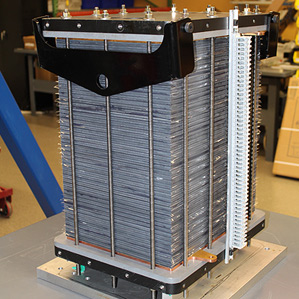Startup Shows Off Its Cheaper Grid Battery
Startup Sun Catalytix is designing a flow battery for grid energy storage that uses custom materials derived from inexpensive commodity chemicals. It joins dozens of other companies seeking to make a device that can cheaply and reliably provide multiple hours of power to back up intermittent wind and solar power.

The MIT spinoff, which hopes to differentiate itself with a novel chemistry and inexpensive mechanical systems, is testing a small-scale five-kilowatt prototype. It projects that a full-scale system, which it expects to make in 2015 or 2016, will cost under $300 per kilowatt-hour, or less than half as much as the sodium-sulfur batteries now used for multihour grid storage.
Sun Catalytix CEO Mike Decelle says one advantage of the company’s technology is that it uses cheap ingredients. “We’re sourcing some this stuff really, really cheaply in ton quantities [from China] right now,” he says, standing in a doorway so the names of the chemicals are not readable to a visitor. “That’s where you’ve got to source and the kind of quantities you need.”
The active material in a typical flow battery is a metal, such as vanadium or zinc, dissolved in a liquid electrolyte. To create a current, the liquids are pumped from large tanks into a device where an electrochemical reaction occurs across a membrane. The electrolytes are pumped in the reverse direction to charge the battery. One big advantage of flow batteries is that the amount of energy they store can be increased by simply making the tanks larger.
Sun Catalytix’s electrolytes are made from metals combined with ligands, or molecules that bind to metal atoms. Using synthetic metal-ligand compounds as the active battery materials gave engineers more design flexibility in pursuing an inexpensive, safe battery that can last 15 years with daily charging, according to the company.
In one version of the battery being developed at its lab, two square plates made of carbon-plastic composite, each about as thick as a piece of paper, are stacked with a thin plastic membrane between them to form a cell. During charging and discharging, the two liquid electrolytes travel through grooves carved within each plate to trigger the chemical reaction across the membrane.
The prototype system, held in a glass enclosure, is made up of 50 cells in two horizontal rows, or “stacks.” The cells are not wired individually; instead, the current travels through the plates from one end of the stack to the other, which saves costs on wiring. Below the stacks are tanks of liquid electrolytes, pumps, valves, and tubes made of PVC plastic—all of which is off-the-shelf equipment. A full-scale system would use hundreds of cells, each roughly the size of a pizza box.
One way Sun Catalytix’s batteries are different from more conventional flow batteries, according to the company, is that the active materials are dissolved in a near-neutral aqueous solution that is safe in the case of a spill and not corrosive to pumps and valves. Most flow-battery electrolytes are strong acids, which could cause safety concerns if the technology is used in buildings and can require containment vessels that introduce more cost, says Venkat Srinivasan, head of the Energy Storage and Distributed Resources Lab at Lawrence Berkeley National Laboratory.
Sun Catalytix is also competing with companies making compressed-air storage machines and batteries with their own novel chemistries, such as a zinc-air battery from Eos Energy Storage and a liquid-metal battery from Ambri. (See “Cheap Batteries for Backup Renewable Energy” and “Ambri’s Better Battery.”) Decelle thinks Sun Catalytix’s battery will have an advantage over Ambri’s in terms of safety. A liquid-metal battery operates at several hundred degrees Celsius, which “might give some customers pause,” he says.
Sun Catalytix intends to pilot-test a full-scale battery in 2015. A one-megawatt system would fit into two 20-foot shipping containers, and the tanks of electrolytes would require more shipping containers, depending on how many hours of power are needed. The company, which has raised $16.5 million in investments, is now seeking more money from corporations and venture capitalists to build larger-scale prototypes. It intends to manufacture the cell stacks itself and rely on contract manufacturers or systems integrators to assemble the final product, Decelle says.
Keep Reading
Most Popular
Large language models can do jaw-dropping things. But nobody knows exactly why.
And that's a problem. Figuring it out is one of the biggest scientific puzzles of our time and a crucial step towards controlling more powerful future models.
The problem with plug-in hybrids? Their drivers.
Plug-in hybrids are often sold as a transition to EVs, but new data from Europe shows we’re still underestimating the emissions they produce.
Google DeepMind’s new generative model makes Super Mario–like games from scratch
Genie learns how to control games by watching hours and hours of video. It could help train next-gen robots too.
How scientists traced a mysterious covid case back to six toilets
When wastewater surveillance turns into a hunt for a single infected individual, the ethics get tricky.
Stay connected
Get the latest updates from
MIT Technology Review
Discover special offers, top stories, upcoming events, and more.